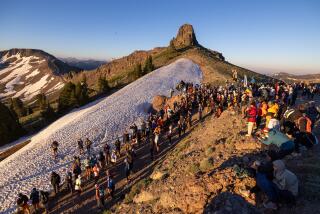In the danger zone
- Share via
“Rock!”
Rebecca Rusch snapped her neck skyward and threw herself hard against the side of the mountain. The gravity of that one-word cry had registered instantly.
“A 300-pound rock whizzed by me inches from my head,” she recalled. It then ping-ponged down the steep gully, missing one of her teammates and two others. “We got lucky.”
But farther down the Cascades’ Illabot Peak, the boulder struck Nigel Aylott in the head. Last month’s death of the 38-year-old Australian near Rockport, Wash., occurred midway through a seven-day, round-the-clock, 400-mile expedition of biking, hiking, paddling and orienteering called the Subaru Primal Quest.
This second recent fatality in the globally thriving endurance sport known as adventure racing underscored the perils of competing amid natural hazards and raised concerns that, with $250,000 in prizes at stake, competitors may be sacrificing safety for speed.
“Yes, there will be more catastrophes,” said adventure racer Isaac Wilson. “No one is holding our hands in this sport. This is true wilderness, and there is a balance between safety and speed.”
Adventure racing took off in 1995 with “The Eco-Challenge,” reality-TV producer Mark Burnett’s precursor to “Survivor.”
A knockoff of the French race Raid Gauloises, the inaugural Eco dropped 50 mixed-gender teams in the Utah badlands to race across 300 miles of desert, mountain, slot canyons, lakes and rapids. Later, TV viewers watched the contestants freeze, sweat, swear, cry, argue and, occasionally, exit via MedEvac.
Soap operas aside, the participants craved the team bonding and the unscripted, off-asphalt challenge.
“Triathlons got boring,” said Kathy Sassin, an early adventure racing star who signed on this year as Primal Quest coordinator. “This was perfect. Away from technology, out in nature, adults learning how to do new things, often in an alien culture.” And organization and determination often trumped youth and athleticism.
Three-hour adventure races, 24-hour races and weekend races sprang up. The Eco-Challenge and the Raid invaded Australia, Borneo, Vietnam, Patagonia and Kyrgyz- stan, where Raid racer Dominique Robert drowned last year.
The sport was so hot that it barely hiccuped when Burnett, on to bigger things, canceled the Eco-Challenge in 2003.
By this year, roughly 80,000 contestants were swarming the backcountry in about 500 U.S. adventure races, including Primal Quest -- up from 30 four years earlier, said Scot Love, publisher of Adventure Sports magazine.
Despite the lack of uniform guidelines, adventure race organizers and participants downplay the risks.
After Aylott’s death, Primal Quest stopped the race and called a meeting of the 39 teams. All but a few elected to continue. The event website called the accident “a tragic reminder of the risks of adventure racing” and detailed the mandatory safety gear, such as GPS units and satellite phones. However, none of it would have helped Aylott.
Racer Wilson believes the sport is as safe as an uncontrolled environment allows -- and getting safer as the money and exposure rise.
Look at the number of noncompetitive climbers and paddlers who die every year, said magazine publisher Love. “In a way, the deaths call attention to how safe it is.”
“It’s not that risky a sport,” said John Jacoby, the racer who slipped and loosened the boulder that killed Aylott. “It’s just bad luck.”
The bad-luck, freak-accident response is common among risk-takers, said Marvin Zuckerman, a professor emeritus of clinical psychology at the University of Delaware and an expert on sensation-seeking. “They’ll just chalk it up to ... one in a million,” he said.
But some insiders blame the tragedy on bad judgment.
“Descending that gulley was a recipe for disaster,” Rusch said. After ascending Illabot Peak together, the two lead teams decided to take the chute rather than a safer route. They all said the first-place prize was not a factor.
Now retired from the sport, Sassin thinks she knows what went wrong. “They thought it couldn’t happen to them,” she said. “In a decade of racing, there wasn’t one event where I didn’t say, ‘I can’t believe we got through that.’ ”
More to Read
Sign up for The Wild
We’ll help you find the best places to hike, bike and run, as well as the perfect silent spots for meditation and yoga.
You may occasionally receive promotional content from the Los Angeles Times.






